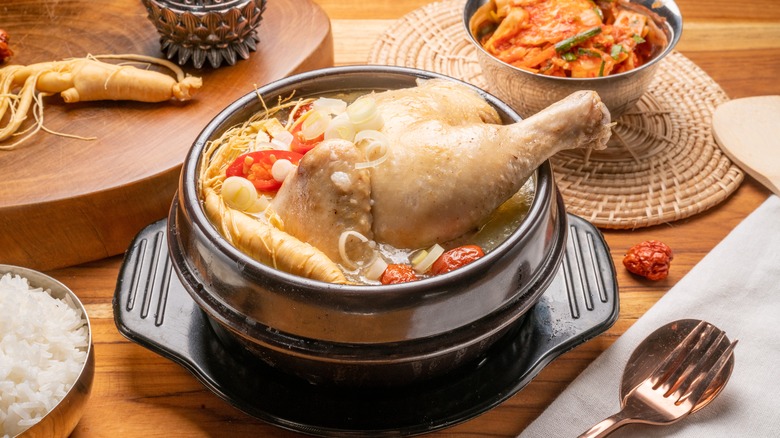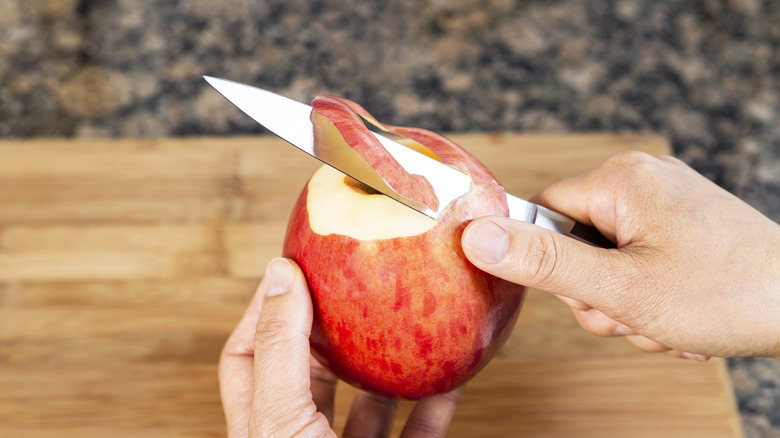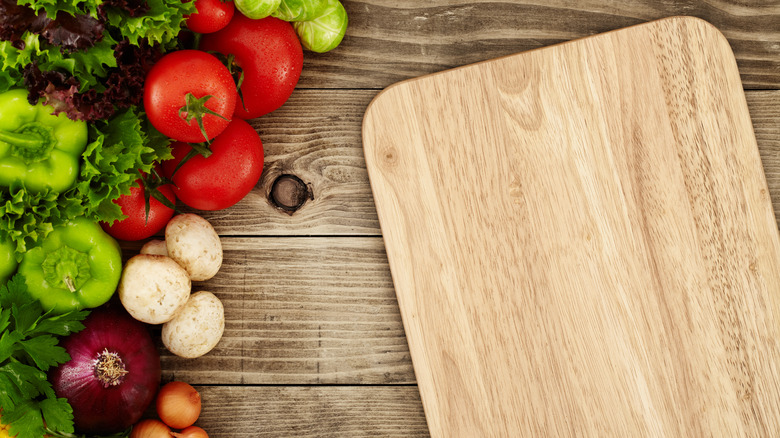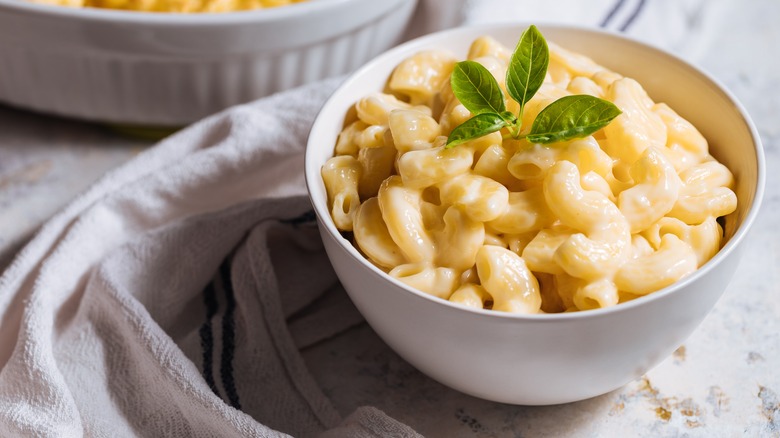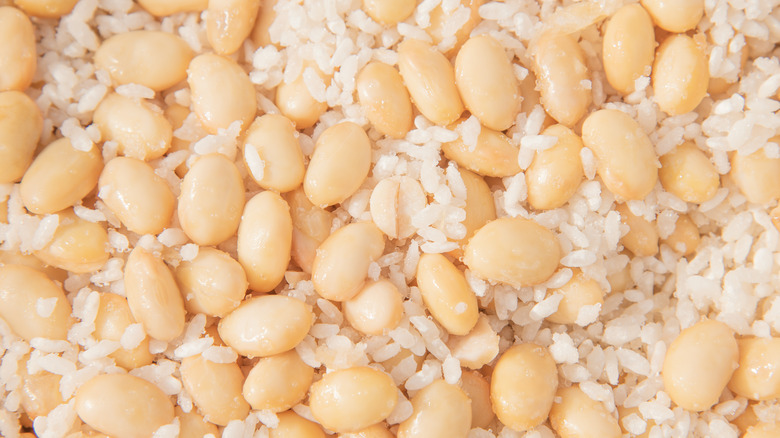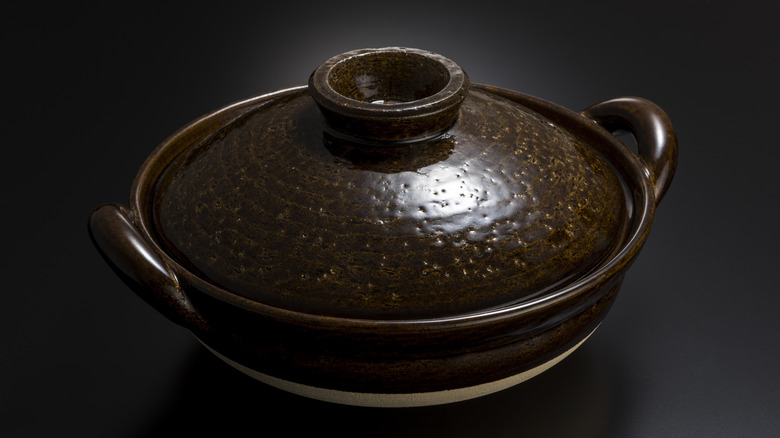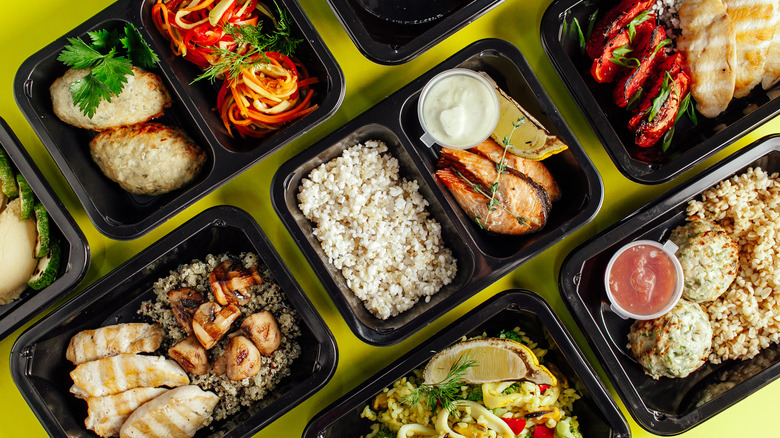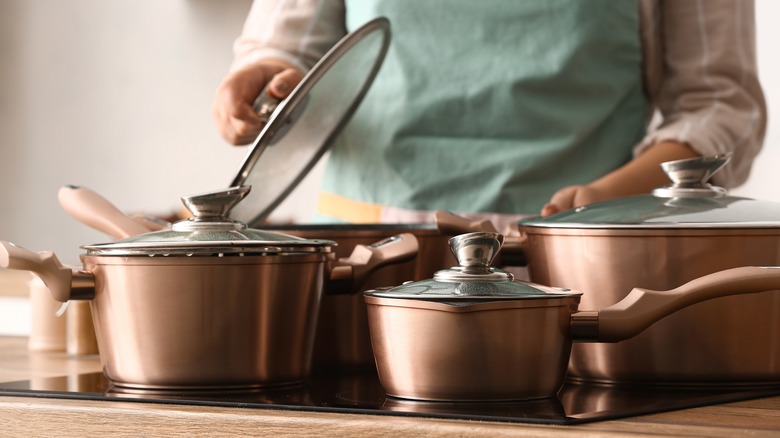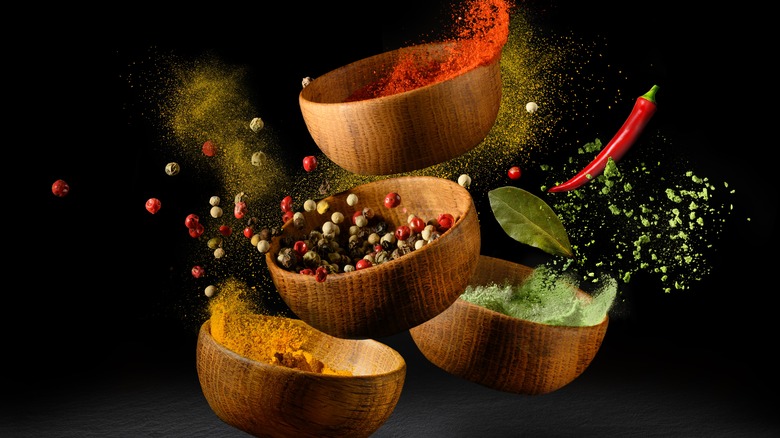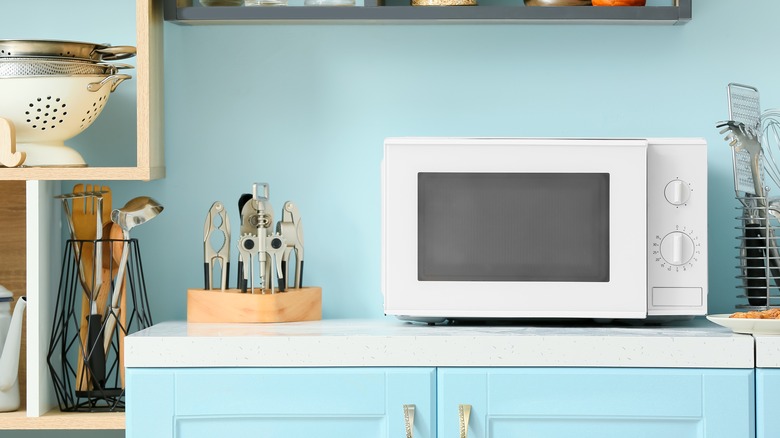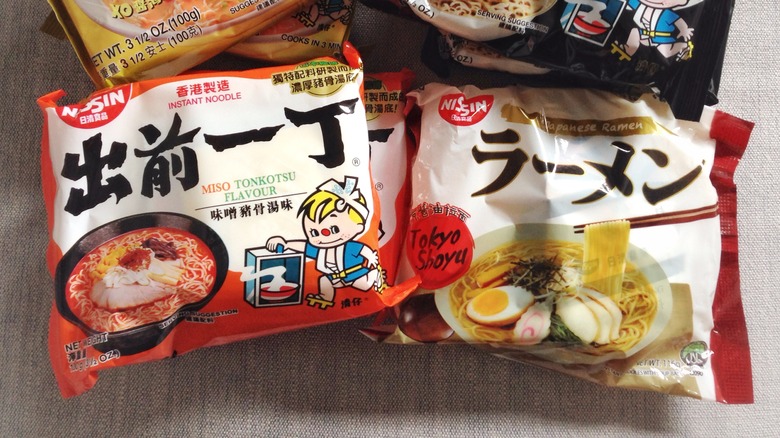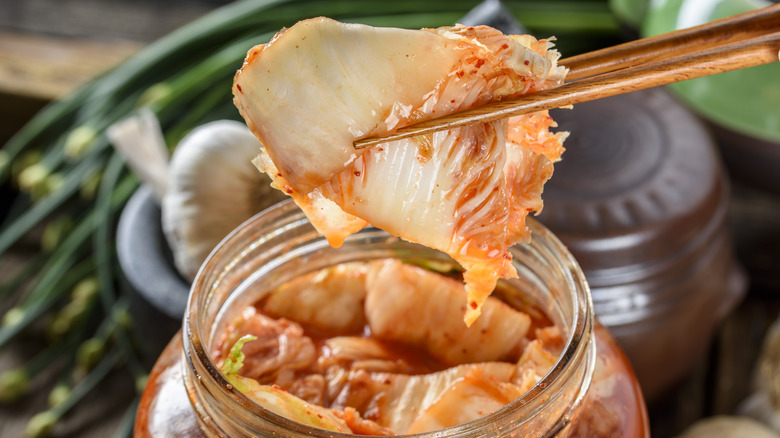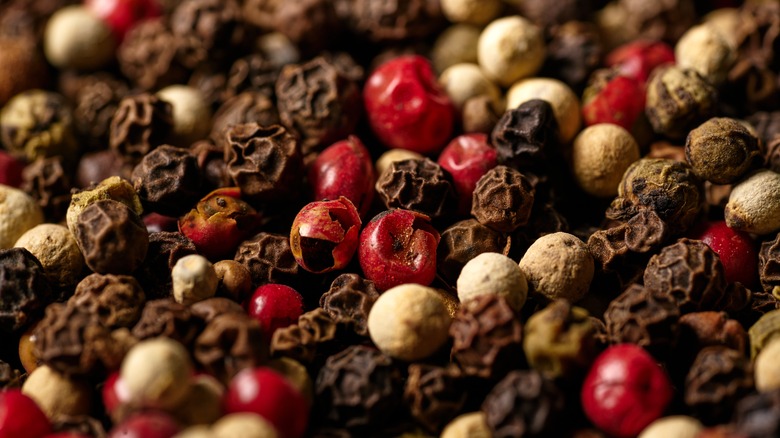David Chang's 15 Best Cooking Tips For Home Chefs
We may receive a commission on purchases made from links.
In the cutthroat world of restaurateurs, David Chang has managed to rise above the fray and make a lasting impact. With his magnetic personality and revolutionary, sometimes surprising cooking methods, Chang has become an iconic figure in the culinary realm, known even to those who have yet to try his mouth-watering dishes, making a name for himself a through popular podcast, a Netflix series, and of course, his restaurant empire, which includes the acclaimed Momofuku.
Chang's approach to cooking is a delightful fusion of tradition and innovation, or as he put it in an article he wrote for Wired, it is "the new and familiar woven together in a strange loop." Drawing inspiration from his Korean heritage, he pays homage to his roots while pushing conventional cooking boundaries, including by using unlikely tools such as the microwave, as we will see. Perhaps even more striking is Chang's ability to harmonize unexpected flavors, such as miso and sweet corn or fermented black beans paired with tender pork. Whatever the case, the result tends to be an extraordinary sensory experience. Let's take a look at some of the ways in which he achieves that as tips you can apply in your own kitchen.
1. Add lots of seasoning to your broth
According to Chang, your broth should be so good in and of itself that it already acts as a practically standalone dish. The way to achieve this is at once simple and complicated, in true David Chang style. The trick is seasoning. As he wrote in Wired, "normally we think of a balanced dish as being neither too salty nor undersalted. I think that's wrong. When a dish is perfectly seasoned, it will taste simultaneously like it has too much salt and too little salt." So that's all you have to do! Just kidding. In a more practical sense, his advice is to add salt, herbs, spices, and aromatics to taste so that your broth already has plenty of flavor before you add your meat or vegetables.
The next step is to select a large pot so that you have room to make mistakes — such as putting in too much salt, which can be fixed by adding more water — and finally add the chicken, or ingredient of choice. Cook it through for about 45 minutes and your magical brew is ready.
2. Use an inexpensive paring knife
If you're an avid home cook, you probably have a few paring knives lying around. But if you don't, not to worry: you can buy one for under $10 and get the job done just as easily as if you'd purchased a fancy one. In fact, in a video on his Instagram account, Chang says there's no need to go above that price tag, and that this has been the norm in most of the kitchens he's worked in. It's the cheap kitchen tool Chang uses all the time. A basic model will work just as well as anything to mince, chop, and slice, and when the blade gets dull, it can easily be sharpened at home.
Just make sure that you pick a model that fits your grip. The paring knife should basically act as an extension of your hand, so you'll want to pick something that feels comfortable and affords you a lot of control.
3. Always use a good cutting board
Your paring knife doesn't have to be fancy, but maybe your cutting board should be. In fact, Chang might judge you based on your cutting board situation. He recommends steering clear of flimsy plastic models and going straight for the solid wood cutting board. The key is to get something sturdy that will withstand the hours and hours of cutting and slicing you'll be doing as you prepare your winter soups or summer salads. And by withstand, we mean something that won't develop scratches or grooves at the first sign of a sharp knife. These can trap bacteria that might then seep into your food, even after cleaning the cutting board.
Bamboo and maple cutting boards are less prone to such scarring, so they're preferable to plastic or soft woods, like cypress. Wood is also naturally antimicrobial, so it can keep your food safe with a greater degree of confidence. Also, wood is just prettier. Just make sure you don't stick your wooden cutting board in the dishwasher, as this may dry it out, causing it to crack or split.
4. Prepare macaroni and cheese in a wok
If you don't have a dishwasher, you're going to love this idea for macaroni and cheese made with only one pot. You won't even have to use a colander. All you'll need is one wok, the macaroni ingredients of your choice, and no more than four or five cups of water. Chang recommends cooking the macaroni until the water has almost evaporated completely, then stirring the butter, flour, and cheese directly into your wok. At this point, you can customize it with whatever you like. Breadcrumbs can add texture and a bit of crunch, while truffle oil, truffle cheese, or truffle salt can each add a hint of decadence to the dish.
But if you're feeling like changing things up, just add David Chang's own secret ingredient to your mac and cheese: Worcestershire sauce. As seen on his Instagram account, you can simply add this ingredient last, after your mac and cheese is good and ready.
5. Don't be afraid to experiment with koji
David Chang is widely known for his successful experimentation with fermentation, using black beans, chickpeas, and whatever might be on hand. So it's no surprise that he doesn't shy away from mold. That is exactly what's happening when he makes use of Koji in his cooking. Koji is basically a mold made when a starter culture is applied to rice, barley, soybeans, or any other product that has been inoculated and sterilized. For example, miso is created when a type of koji mold is applied to soybeans, while sake is made through the same process, using rice.
But koji can be much more versatile than that. Chang says his chickpea miso tastes like Parmesan, while Hozon, a koji-cultivated paste used at Momofuku and other restaurants, adds a delicious umami burst of flavor to quick breads, salad dressings, marinades, and even ice cream.
6. Usa a donabe clay pot for braising, steaming, and more
If you're a fan of one-pot cooking, don't limit yourself to the wok or cast-iron skillet. Make sure you also have a versatile donabe in your arsenal. This is a Japanese earthenware pot that comes with a lid and can be used to braise or steam fish on the stove, or you can pop it in the oven to make a stew or a roast. In fact, the adaptability of this pot cannot be overstated. You can use it to make rice by cooking it with water on medium heat for 14 minutes, then letting it sit and steam to perfection for 20 minutes. You can even layer vegetables and meat on top of the rice at the steaming stage to create a full, healthy steamed meal.
And don't forget to use it for your next hot pot meal. It is widely used in Asia to cook a broth into which diners can dip their uncooked meat, seafood, or vegetables, much like a European-style meat fondue, which can be made with broth or hot oil. When it's all over, store your donabe on your open kitchen shelves as an attractive decoration.
7. Avoid buying storage containers for your leftovers
David Chang is not a big fan of waste, or at least we can deduce as much from his advice on leftover containers. He raises an interesting point: why go out and buy plastic containers when you'll be getting them for free next time you order take-out? Such containers will last a few months, after which they may start to degrade and take on bacteria. But if you don't use them at all, they're just going to end up in a landfill, where they will last a lifetime. Approximately 380 million tons of plastic per year is used for a single purpose and then thrown out after just a few minutes.
Just think about how many people order take-out per week and then throw away their empty containers right away. Where do they all go? One shudders to imagine. In fact, some of these containers can't even be recycled. The black plastic ones, for example, are often made from recycled materials, but a plastic recycling plant won't know what to do with them. Best to use them for a while at home, at least until your next take-out order arrives.
8. Surround yourself with copper cookware
Chang would deck out his kitchen with copper cookware because has two main benefits: it makes cooking more efficient, and it looks pretty. In fact, copper is known to be 10 times more conductive than stainless steel, which makes it cook more evenly and heat up the contents faster, including when boiling water. This is great for when you're cooking delicate items that require careful temperature control, like flaky fish or caramel sauce. Copper is also antimicrobial, which means you can use it practically forever and never have to worry about bacteria taking over.
All that sounds like heaven, but be aware that cons do exist. Firstly, copper cookware is incredibly expensive. Even a small pot might set you back $100. Second, copper requires a bit more maintenance than your usual stainless steel items. Oxidation is a constant threat, so the pans need to be hand washed and polished frequently. You can polish your cookware with a copper cleaner and a soft cloth every six months, but you can also use household products including lemon juice or ketchup to fix your copper pans.
9. Put away your recipe and improvise
When a chef of David Chang's renown improvises, the result might end up looking a lot different from what you come up with at home. But don't be intimidated. Improvisation might be just the thing you need to take your amateur cooking skills to the next level. As Chang told House & Home, the goal is to "create something as delicious as possible, in the least amount of time possible, while making as little mess as possible." Easy, right?
Non-recipe recipes from Chang's recent cookbook, "Cooking at Home: Or, How I Learned to Stop Worrying About Recipes (And Love My Microwave)," encourage the home chef to go for what they like and just roll with it. For example, his Family Meal Chicken calls for a whole chicken, or just a few pieces, or whatever, to be arranged on a wire rack and then "season the chicken pieces with lemon, rosemary, and butter under the skin, or with a rub of your choice. Or not." The only lesson to take home here is that the dish will work out best if you place potatoes or vegetables underneath so that the chicken fat can drip on them and flavor them automatically.
10. Don't snub the microwave
After the microwave was first rolled out to residential consumers in the 1960s, it experienced a massive boom, with 80% of American households owning a device by 1993. But ever since 2004, sales have dwindled by up to 40%. This is in part due to a saturation of the market, but also to a growing preference for fresh food and a perception that microwaves zap out some of a food's nutritional content, though this has proven to be untrue. Whatever the case, microwave cooking has gotten a bad rap.
Not so in David Chang's kitchen. He has been known to use this cooking tool to make anything from flaky salmon to mashed potatoes. In the first case, just place your salmon filet in a microwave-safe container, pour some soy sauce and agave on top, making sure it's evenly distributed, and season with salt and pepper. Place the salmon in the microwave, cover it loosely, and zap it for three and a half minutes for a medium-rare filet. For the mashed potatoes, just peel and cube your potatoes as you normally would, then season them and place them in the microwave inside a microwave-safe lidded container. Zap them for eight minutes, and then add your butter and milk and mash as usual. That should all take about 10 minutes, and that is literally all there is to it.
11. Pair your food with cheap beer
We all love a bit of cheap beer, whether we want to admit it or not. Actually, we also love good beer, because who can say no to a good craft brew? The truth is that we just love all beer, so when it comes to pairing it with food with strong flavors, such as David Chang's work, it's best to go light, breezy and cheap, so as not to interfere with the spiciness, umami, or what have you.
Chang is not alone in thinking this. If you've ever been to a restaurant that serves a menu of mostly spicy foods, such as a Thai or Indian place, you might have noticed that most beers available are pretty easy on the wallet. Orion and Tiger come to mind. Meanwhile, closer to home, in the Midwest to be precise, for decades people have been pairing cheap beer with pickles, another strong flavor, just to make the drink taste better. So the flavor enhancement goes both ways. It's a win-win.
12. Cook instant ramen in cheese water
One of David Chang's core tenets is that you don't always need fancy ingredients to make a fancy dish. In fact, one of the ingredients he suggests using to make his signature cacio e pepe is ramen noodles straight out of the packet. That's right, the instant kind. Although his version is a far cry from the traditional Italian dish, the ingredients are mostly the same, and the result is still delicious, which is the important part.
To make David Chang's version, you just need some instant ramen noodles and your homemade cheese broth, made with finely grated Pecorino Romano, melted butter, and enough water to cover the noodles and rehydrate them. Combine the ingredients until the noodles are soft and the water has reduced, though you might have to pour some of it out at the end. And if you don't know what to do with that leftover ready-made mix in your instant noodle packet, just use it on your next batch of roasted potatoes.
13. Use good quality ingredients
Any chef is only as good as the quality of their ingredients. A tomato sauce is simply going to turn out better if you use good tomatoes to make it. This is especially true of kimchi, and if you've never made it at home before, now is the time to try it. First of all, David Chang says to get hold of the best possible cabbage money can buy, and counterintuitively, make sure it is as fresh as possible. Even though you're about to make a fermented food item, using almost spoiled cabbage can get your fermentation process off on the wrong foot. Next, quarter your cabbage before washing and draining it. Then add the salt and sugar cure, and mix well along with your seasoning: this can be prepared with almost anything, but most kimchi recipes will include ginger, garlic, chili flakes, and some form of fish product, like anchovies, shrimp salt, or fish sauce.
Lastly, it's time to store the kimchi until it's ready. Keep it in a sealed container placed in a cool, dark place until it starts to ferment — about 48 hours — then place it in the fridge for about two weeks.
14. Mix miso with softened butter
David Chang is no fan of American-produced miso and he's not afraid to hide it. He maintains that it has too much sodium and tastes too salty. But that doesn't mean we have to go all the way to Japan to get this ingredient. All we have to do to undercut the saltiness is mix it with butter. This trick also works when you feel you might have added too much miso to a dish.
Once you've got your balance of flavor down pat, you can use miso in a whole host of recipes. The world-famous miso soup is one dish everyone should try at least once, but you can also rub it on salmon, creating a beautiful salty and sweet glaze, or add it to your braised pork belly. But don't stop at the main course: Miso's combination of saltiness and umami can go great with certain baked goods, like banana bread or caramel cake.
15. Avoid pre-ground black pepper
According to Chang, pre-ground black pepper is an abomination that should only be used when there's literally no other option. The stuff can be flat and tasteless, especially if it's been sitting on a shelf for months on end. Once pepper is cracked and the aromas seep out, it loses its flavor within about a half hour. And some of it isn't even pure, but made with other ingredients, including papaya seeds that are ground and mixed with pepper and passed off as the real deal. In contrast, freshly ground peppercorns are a thing of beauty, so why risk it? Next time you go to the store be sure to grab a few containers of fresh peppercorns. You can pour them into your pepper grinder or you can buy peppercorns from the store with a built-in pepper mill. If you want to get really fancy, you can even sprinkle some peppercorns in your mortar and crack them up with a pestle.
The thing to remember is that pre-ground black pepper will do next to nothing for your meal. But freshly-ground pepper can even enhance your taste buds by causing you to salivate more, which in turn leads to a fuller sensory experience.

